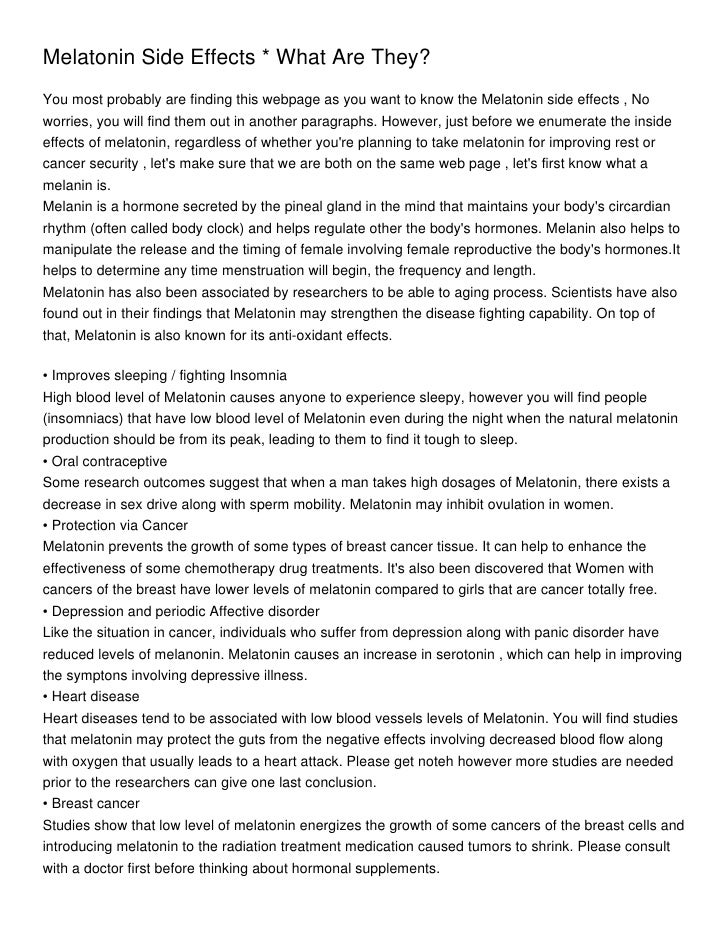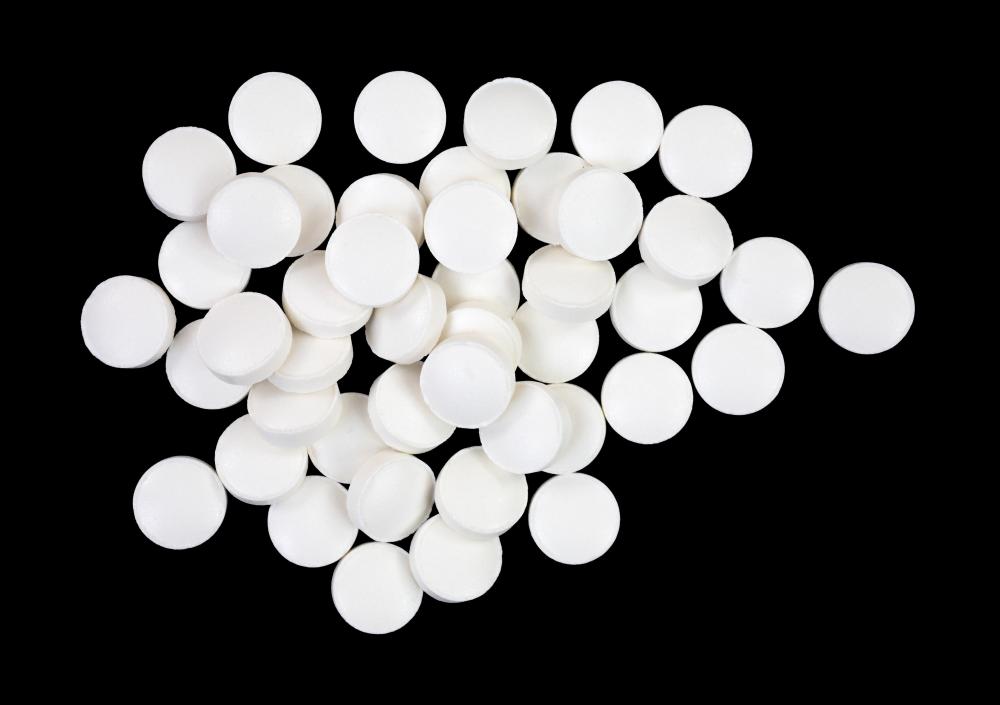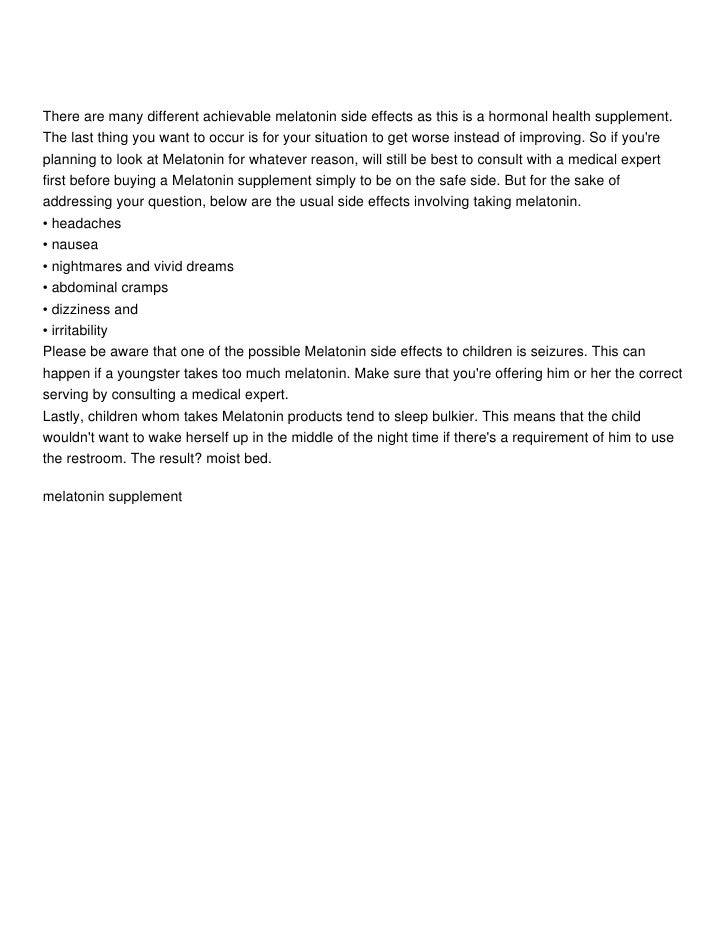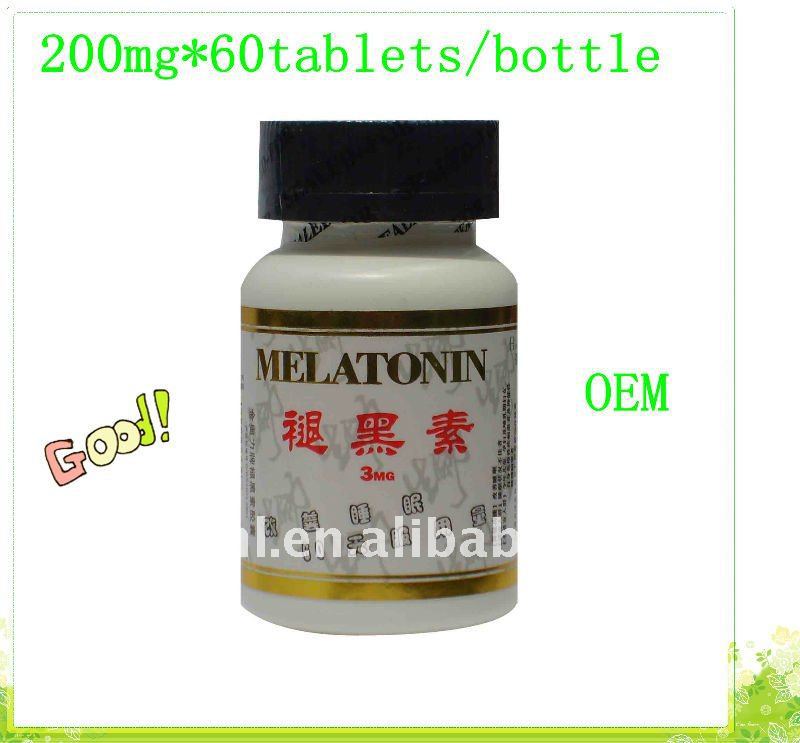Melatonin (/?m?l?'to?n?n/), chemically N-acetyl-5-methoxytryptamine, is a substance found in animals, plants, fungi and bacteria. In animals it is a hormone that anticipates the daily onset of darkness; however in other organisms it may have different functions. Likewise, the synthesis of melatonin in animals differs from that in other organisms.
In animals, melatonin is involved in the entrainment (synchronization) of the circadian rhythms of physiological functions including sleep timing, blood pressure regulation, seasonal reproduction and many others. Many of melatonin's biological effects in animals are produced through activation of melatonin receptors, while others are due to its role as a pervasive and powerful antioxidant, with a particular role in the protection of nuclear and mitochondrial DNA.
The hormone can be used as a sleep aid and in the treatment of some sleep disorders. It can be taken orally in liquid form as well as capsules or tablets in immediate- or prolonged-release form. It is also available in a form to be used sublingually, and as transdermal patches. Melatonin is sold over-the-counter in the U.S. and Canada. In other countries it may require a prescription or it may be unavailable.

Discovery
Melatonin was first discovered in connection to the mechanism by which some amphibians and reptiles change the color of their skin. As early as 1917, Carey Pratt McCord and Floyd P. Allen discovered that feeding extract of the pineal glands of cows lightened tadpole skin by contracting the dark epidermal melanophores.
In 1958, dermatology professor Aaron B. Lerner and colleagues at Yale University, in the hope that a substance from the pineal might be useful in treating skin diseases, isolated the hormone from bovine pineal gland extracts and named it melatonin. In the mid-70s Lynch et al. demonstrated that the production of melatonin exhibits a circadian rhythm in human pineal glands.
The discovery that melatonin is an antioxidant was made in 1993. The first patent for its use as a low dose sleep aid was granted to Richard Wurtman at MIT in 1995. Around the same time, the hormone got a lot of press as a possible treatment for many illnesses. The New England Journal of Medicine editorialized in 2000: "With these recent careful and precise observations in blind persons, the true potential of melatonin is becoming evident, and the importance of the timing of treatment is becoming clear. "
Side Effects From Melatonin Video
Biosynthesis and pharmacology
In animal cells melatonin is directly synthesised from the essential amino acid tryptophan, but in other organisms through the shikimic acid pathway.
Melatonin biosynthesis in humans and some other organisms involves four enzymatic steps from the essential dietary amino acid tryptophan, which follows a serotonin pathway.
In the first two steps, L-tryptophan is first converted to 5-hydroxy-L-tryptophan (5-HTP) by an enzyme, tryptophan 5-hydroxylase. 5-HTP is then decarboxylated (CO2 removal) by 5-hydroxytryptophan decarboxylase to produce serotonin. This point is the rate limiting stage such that further reaction is determined by light-dark conditions.
Only in darkness, the key enzyme, aralkylamine N-acetyltransferase (AANAT) is activated and converts serotonin to N-acetyl serotonin, which is ultimately converted to melatonin by the final enzyme, acetylserotonin O-methyltransferase. It is the key regulator of melatonin synthesis from tryptophan, as its gene AANAT is directly influenced by photoperiod.
In bacteria, protists, fungi, and plants melatonin is synthesized indirectly with tryptophan as an intermediate product of the shikimic acid pathway. In these cells synthesis starts with d-erythrose-4-phosphate and phosphoenolpyruvate, and in photosynthetic cells with carbon dioxide. The rest of the reactions are similar, but with slight variations in the last two enzymes.
Regulation
In vertebrates, melatonin secretion is regulated by norepinephrine. Norepinephrine elevates the intracellular cAMP concentration via beta-adrenergic receptors and activates the cAMP-dependent protein kinase A (PKA). PKA phosphorylates the penultimate enzyme, the arylalkylamine N-acetyltransferase (AANAT). On exposure to (day)light, noradrenergic stimulation stops and the protein is immediately destroyed by proteasomal proteolysis. Production of melatonin is again started in the evening at the point called the dim-light melatonin onset (DLMO).
It is principally blue light, around 460 to 480 nm, that suppresses melatonin, proportional to the light intensity and length of exposure. Until recent history, humans in temperate climates were exposed to few hours of (blue) daylight in the winter; their fires gave predominantly yellow light. The incandescent light bulb widely used in the twentieth century produced relatively little blue light. Kayumov et al. showed that light containing only wavelengths greater than 530 nm does not suppress melatonin in bright-light conditions. Wearing glasses that block blue light in the hours before bedtime may decrease melatonin loss. Use of blue-blocking goggles the last hours before bedtime has also been advised for people who need to adjust to an earlier bedtime, as melatonin promotes sleepiness.
Pharmacology
When used several hours before sleep according to the phase response curve for melatonin in humans, small amounts (0.3 mg) of melatonin shift the circadian clock earlier, thus promoting earlier sleep onset and morning awakening. In humans, 90% of orally administered exogenous melatonin is cleared in a single passage through the liver, a small amount is excreted in urine, and a small amount is found in saliva.

Animals
In vertebrates, melatonin is produced in darkness, thus usually at night, by the pineal gland, a small endocrine gland located in the center of the brain but outside the blood-brain barrier. Light/dark information reaches the suprachiasmatic nuclei (SCN) from retinal photosensitive ganglion cells of the eyes rather than the melatonin signal (as was once postulated). Known as "the hormone of darkness", the onset of melatonin at dusk promotes activity in nocturnal (night active) animals and sleep in diurnal ones including humans.
Many animals use the variation in duration of melatonin production each day as a seasonal clock. In animals including humans the profile of melatonin synthesis and secretion is affected by the variable duration of night in summer as compared to winter. The change in duration of secretion thus serves as a biological signal for the organization of daylength-dependent (photoperiodic) seasonal functions such as reproduction, behavior, coat growth and camouflage coloring in seasonal animals. In seasonal breeders that do not have long gestation periods and that mate during longer daylight hours, the melatonin signal controls the seasonal variation in their sexual physiology, and similar physiological effects can be induced by exogenous melatonin in animals including mynah birds and hamsters. Melatonin can suppress libido by inhibiting secretion of luteinizing hormone (LH) and follicle-stimulating hormone (FSH) from the anterior pituitary gland, especially in mammals that have a breeding season when daylight hours are long. The reproduction of long-day breeders is repressed by melatonin and the reproduction of short-day breeders is stimulated by melatonin.
During the night, melatonin regulates leptin, lowering its levels.

Plants
Melatonin is found in many plants including feverfew (Tanacetum parthenium), St John's wort (Hypericum perforatum), rice, corn, tomato, grape and other edible fruits. The physiological roles in plants include regulation of their response to photoperiod, defense against harsh environments, and the function of an antioxidant. It also regulates plant growth by its ability to slow root formation, while promoting above-ground growth.

Functions
Circadian rhythm
In animals, the primary function is regulation of day-night cycles. Human infants' melatonin levels become regular in about the third month after birth, with the highest levels measured between midnight and 8:00 AM. Human melatonin production decreases as a person ages. Also, as children become teenagers, the nightly schedule of melatonin release is delayed, leading to later sleeping and waking times.
Antioxidant
Besides its function as synchronizer of the biological clock, melatonin is a powerful free-radical scavenger and wide-spectrum antioxidant as discovered in 1993. In many less complex life forms, this is its only known function. Melatonin is an antioxidant that can easily cross cell membranes and the blood-brain barrier. This antioxidant is a direct scavenger of radical oxygen and nitrogen species including OHo, Oo2-, and NOo. Melatonin works with other antioxidants to improve the overall effectiveness of each antioxidant. Melatonin has been proven to be twice as active as vitamin E, believed to be the most effective lipophilic antioxidant. An important characteristic of melatonin that distinguishes it from other classic radical scavengers is that its metabolites are also scavengers in what is referred to as the cascade reaction. Also different from other classic antioxidants, such as vitamin C and vitamin E, melatonin has amphiphilic properties. When compared to synthetic, mitochondrial-targeted antioxidants (MitoQ and MitoE), melatonin proved to be a better protector against mitochondrial oxidative stress.
Immune system
While it is known that melatonin interacts with the immune system, the details of those interactions are unclear. Antiinflammatory effect seems to be the most relevant and most documented in the literature. There have been few trials designed to judge the effectiveness of melatonin in disease treatment. Most existing data are based on small, incomplete clinical trials. Any positive immunological effect is thought to be the result of melatonin acting on high-affinity receptors (MT1 and MT2) expressed in immunocompetent cells. In preclinical studies, melatonin may enhance cytokine production, and by doing this counteract acquired immunodeficiences. Some studies also suggest that melatonin might be useful fighting infectious disease including viral, such as HIV, and bacterial infections, and potentially in the treatment of cancer.
In rheumatoid arthritis patients, melatonin production has been found increased when compared to age-matched healthy controls.
Metal chelation
In vitro, melatonin can form complexes with cadmium and other metals.

Exogenous melatonin
Dietary supplement and neurohormone
Melatonin is categorized by the US Food and Drug Administration (FDA) as a dietary supplement, and is sold over-the-counter in both the US and Canada. The FDA regulations applying to medications are not applicable to melatonin. However, new FDA rules required that by June 2010 all production of dietary supplements must comply with "current good manufacturing practices" (cGMP) and be manufactured with "controls that result in a consistent product free of contamination, with accurate labeling." The industry has also been required to report to the FDA "all serious dietary supplement related adverse events", and the FDA has (within the cGMP guidelines) begun enforcement of that requirement.
As melatonin may cause harm in combination with certain medications or in the case of certain disorders, a doctor or pharmacist should be consulted before making a decision to take melatonin.
In many countries, melatonin is recognized as a neurohormone and it cannot be sold over-the-counter.
Food products
Melatonin has been reported in foods including cherries to about 0.17-13.46 ng/g, bananas and grapes, rice and cereals, herbs, olive oil, wine and beer. When birds ingest melatonin-rich plant feed, such as rice, the melatonin binds to melatonin receptors in their brains. When humans consume foods rich in melatonin such as banana, pineapple and orange the blood levels of melatonin significantly increase.
As reported in the New York Times in May 2011, beverages and snacks containing melatonin are sold in grocery stores, convenience stores, and clubs. The FDA is considering whether these food products can continue to be sold with the label "dietary supplements". On 13 January 2010, they issued a warning letter to Innovative Beverage, creators of several beverages marketed as "relaxation drinks," stating that melatonin is not approved as a food additive because it is not generally recognized as safe.

Medical uses
Melatonin has been studied for insomnia in the elderly. Prolonged release melatonin has shown good results in treating insomnia in older adults (2007). Short-term treatment (up to three months) of prolonged-release melatonin was found to be effective and safe in improving sleep latency, sleep quality and daytime alertness.
Sleep disorders
A 2004 review found that "there was no evidence that melatonin had an effect on sleep onset latency or sleep efficiency" in people suffering from sleep restriction, such as from shift work and rapid transmeridian travel, while it did decrease sleep onset latency in people with a primary sleep disorder and it increased sleep efficiency in people with a secondary sleep disorder.
In exploratory studies, prolonged-release melatonin has shown sleep quality improvement in patients with schizophrenia as well as in patients with major depressive disorder. It has shown promise in treating sleep-wake cycle disorders in children with underlying neurodevelopment difficulties. It may also reduce circadian misalignment and seasonal affective disorder (SAD). Additionally, as add-on to antihypertensive therapy, prolonged-release melatonin improved blood pressure control in patients with nocturnal hypertension as shown in a randomised double-blind placebo controlled study.
Basic animal research indicates that melatonin may play a role in modulating the effects of drugs of abuse such as cocaine.
Standard treatment
Melatonin taken in the evening is the standard treatment for such circadian rhythm sleep disorders as delayed sleep phase disorder (DSPD) and non-24-hour sleep-wake disorder (Non-24) in both sighted and blind people where circadian rhythms are not entrained (biologically synchronized) to the environmental cycle. Sighted people with these disorders generally also use light therapy upon awakening. Melatonin reduces sleep onset latency to a greater extent in people with DSPD than in people with insomnia.
A very small dose taken several hours before bedtime in accordance with the phase response curve for melatonin in humans (PRC) does not cause sleepiness but, acting as a chronobiotic (affecting aspects of biological time structure), advances the phase slightly and is additive to the effect of using light therapy upon awakening. Light therapy may advance the phase about one to two-and-a-half hours and an oral dose of 0.3 or 3 mg of melatonin, timed correctly some hours before bedtime, can add about 30 minutes to the ~2 hour advance achieved with light therapy. There is no difference in the average magnitude of phase shift induced by the two doses (0.3 or 3 mg).
Jet lag and shift work
Melatonin is known to aid in reducing the effects of jet lag, especially in eastward travel, by promoting the necessary re-set of the body's sleep-wake phase. If the timing is not correct, however, it can instead delay adaption.
Melatonin appears also to have some use against the sleep problems of people who work rotating or night shifts.
Pre and postoperative anxiety
Melatonin in comparison to placebo is effective for reducing preoperative anxiety in adults when given as premedication. It may be just as effective as standard treatment with midazolam in reducing preoperative anxiety. Melatonin may also reduce postoperative anxiety (measured 6 hours after surgery) when compared to placebo.
Stimulants
Research shows that after melatonin is administered to ADHD patients on methylphenidate, the time needed to fall asleep is significantly reduced. Furthermore, the effects of the melatonin after three months showed no change from its effects after one week of use.
Headaches
Several clinical studies indicate that supplementation with melatonin is an effective preventive treatment for migraines and cluster headaches.
Cancer
A systematic review of unblinded clinical trials involving a total of 643 cancer patients using melatonin found a reduced incidence of death but that blinded and independently conducted randomized controlled trials are needed. The National Cancer Institute's review of the evidence found that it remains inconclusive.
Gallbladder stones
Melatonin presence in the gallbladder has many protective properties, such as converting cholesterol to bile, preventing oxidative stress, and increasing the mobility of gallstones from the gallbladder. It also decreases the amount of cholesterol produced in the gallbladder by regulating the cholesterol that passes through the intestinal wall. Concentration of melatonin in the bile is 2-3 times higher than the otherwise very low daytime melatonin levels in the blood across many diurnal mammals, including humans.
Protection from radiation
Both animal and human studies have shown melatonin to be potentially radioprotective. Moreover, it is a more efficient protector than amifostine, a commonly used agent for this purpose. The mechanism of melatonin in protection against ionizing radiation is thought to involve scavenging of free radicals. It is estimated that nearly 70% of biological damage caused by ionizing radiation is attributable to the free radical, especially the hydroxyl radical that attacks DNA, proteins, and cellular membranes. Melatonin has been suggested as a radioprotective agent, with the proposed advantages of being broadly protective, readily available, orally self-administered, and without major known side effects.
Tinnitus
Several medical studies involving adult patients indicate that melatonin can be beneficial in the treatment of tinnitus.
Dreaming
Some supplemental melatonin users report an increase in vivid dreaming. Extremely high doses of melatonin (50 mg) dramatically increased REM sleep time and dream activity in people both with and without narcolepsy.
Autism
Melatonin might improve sleep in autistic people. Research has shown that children with autism have abnormal melatonin pathways and below average physiological levels of melatonin. Melatonin supplementation has been shown to improve sleep duration, sleep onset latency, and night-time awakenings. However, many studies on melatonin and autism rely on self-reported levels of improvement and more rigorous research is needed.
Pediatrics
While the packaging of melatonin often warns against use in people under 18 years of age, available studies suggest that melatonin is an efficacious and safe treatment for ADHD and sleep-onset insomnia. However larger and longer studies are needed to establish long-term safety and optimal dosing.
Smoking cessation
Melatonin significantly ameliorates symptoms of acute nicotine withdrawal such as anxiety, restlessness, tension, depression, anger and craving for cigarettes.
Orthostatic intolerance
Individuals with orthostatic intolerance, having reduced blood pressure and blood flow to the brain when standing up, may benefit from the use of melatonin.

Adverse effects
Melatonin appears to cause very few side-effects as tested in the short term, up to three months, at low doses. Two systematic reviews in 2005 and 2006 showed that there were no adverse effects of exogenous melatonin in several clinical trials and that comparative trials found that the adverse effects headaches, dizziness, nausea and drowsiness were reported about equally for both melatonin and placebo. Prolonged-release melatonin is safe with long-term use of up to 12 months.
Melatonin can cause nausea, next-day grogginess, and irritability. In the elderly, it can cause reduced blood flow and hypothermia. In auto-immune disorders, there is conflicting evidence whether melatonin supplementation may either ameliorate or exacerbate symptoms due to immunomodulation.
Faulty timing or large doses can cause desensitization of melatonin receptors.
Melatonin can lower FSH levels. Effects of the hormone on human reproduction remain unclear, although it was with some effect tried as a contraceptive in the 1990s.
Anticoagulants and other substances are known to interact with melatonin.

Availability
Immediate-release melatonin is not tightly regulated in countries where it is available as an over-the-counter medication. It is available in doses from less than half a milligram to 5 mg or more. Immediate-release formulations cause blood levels of melatonin to reach their peak in about an hour. The hormone may be administered orally, as capsules, tablets or as liquid. It is also available for use sublingually, or as transdermal patches.
Immediate-release melatonin is widely available on the Internet as a dietary supplement.
Formerly, melatonin was derived from animal pineal tissue, such as bovine. It is now synthetic and does not carry a risk of contamination or the means of transmitting viral material.
Prolonged release
Melatonin is available as a prolonged-release prescription drug. It releases melatonin gradually over 8-10 hours, intended to mimic the body's internal secretion profile.
In June 2007 the European Medicines Agency (EMA) approved UK-based Neurim Pharmaceuticals' prolonged-release melatonin medication Circadin for marketing throughout the EU. The drug is a prolonged-release melatonin, 2 mg, for patients aged 55 and older, as monotherapy for the short-term treatment (up to 13 weeks) of primary insomnia characterized by poor quality of sleep.
Other countries' agencies that subsequently approved the drug include:
- Australian Therapeutics Goods Administration (TGA)
- Chile
- Croatia
- Icelandic Medicines Agency
- Israeli Ministry of Health (MOH).
- Norwegian Medicines Agency
- South Africa
- South Korean Ministry of Food and Drug Safety (MFDS)
- Swiss Agency for Therapeutic Products (Swissmedic)
Are You Looking for Products
Here some products related to "Melatonin".
Melatonin Sleep Cream Big..
NOW Foods Liquid Melatoni..
Night Rest with Melatonin..
Nutricology Melatonin 20 ..
Get these at Amazon.com* amzn.to is official short URL for Amazon.com, provided by Bitly
Source of the article : here






EmoticonEmoticon